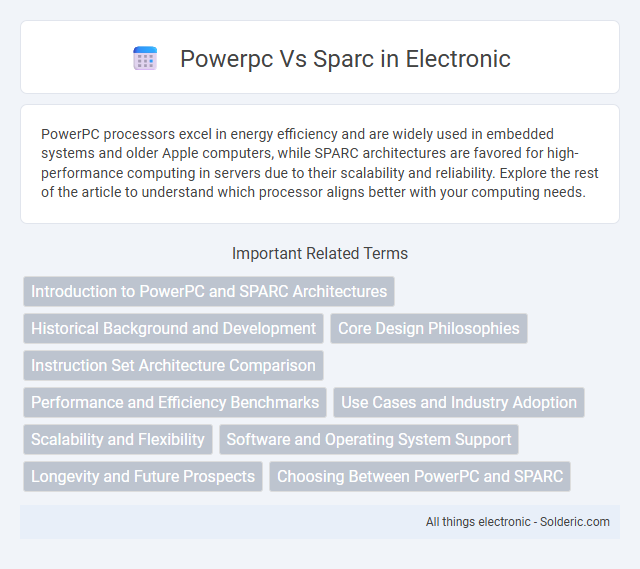PowerPC processors excel in energy efficiency and are widely used in embedded systems and older Apple computers, while SPARC architectures are favored for high-performance computing in servers due to their scalability and reliability. Explore the rest of the article to understand which processor aligns better with your computing needs.
Comparison Table
| Feature | PowerPC | SPARC |
|---|---|---|
| Architecture | RISC (Reduced Instruction Set Computing) | RISC (Reduced Instruction Set Computing) |
| Developed By | IBM, Motorola, Apple (AIM alliance) | Sun Microsystems, Oracle |
| Instruction Set | 32-bit and 64-bit | 32-bit and 64-bit |
| Primary Usage | Embedded systems, servers, gaming consoles | Servers, workstations, high-end computing |
| Register Windows | No | Yes |
| Endianness | Bi-endian (supports little and big endian) | Big-endian |
| Pipeline Architecture | Variable; advanced superscalar implementations | Deep pipeline with register windows |
| Typical Clock Speeds | Up to 4+ GHz (depends on generation) | Up to 5+ GHz (latest generations) |
| Example Processors | PowerPC 601, 603, 604, G3, G4, G5 | UltraSPARC series, SPARC T-series |
| Operating Systems | macOS (older versions), AIX, Linux, QNX | Solaris, Linux, BSD variants |
| Market Status | Used mostly in embedded and legacy systems | Used primarily in enterprise and server markets |
Introduction to PowerPC and SPARC Architectures
PowerPC architecture, developed by IBM, Motorola, and Apple, emphasizes RISC design for high-performance embedded and computing systems. SPARC, created by Sun Microsystems, features a scalable RISC architecture optimized for server and workstation environments with a focus on parallel processing. You should consider PowerPC for versatile applications and SPARC for enterprise-grade reliability and scalability.
Historical Background and Development
PowerPC, developed in the early 1990s by the AIM alliance (Apple, IBM, Motorola), was designed as a RISC architecture to compete with Intel's x86 processors and support diverse computing platforms including personal computers and embedded systems. SPARC, launched by Sun Microsystems in 1987, originated as a scalable RISC architecture widely adopted in enterprise servers and workstations, prioritizing high performance and multiprocessing capabilities. Both architectures have influenced modern computing with PowerPC excelling in embedded and aerospace applications, while SPARC has driven innovation in server-grade performance and reliability.
Core Design Philosophies
PowerPC architecture emphasizes RISC principles with a focus on high instruction throughput and energy efficiency, aiming for broad compatibility across embedded systems and personal computers. SPARC architecture prioritizes scalable thread-level parallelism through its multi-threading and register window designs, targeting enterprise servers with high reliability and performance under multi-user workloads. Both architectures optimize for low-latency pipelines but diverge in application focus and concurrency management strategies.
Instruction Set Architecture Comparison
PowerPC utilizes a RISC (Reduced Instruction Set Computer) architecture designed for simplicity and efficiency with fixed-length instructions, enabling faster processing and easier pipelining. In contrast, SPARC implements a RISC architecture featuring a unique register windowing system that optimizes procedure calls and reduces memory access latency. Your choice between PowerPC and SPARC should consider the specific instruction set advantages related to application performance and system design requirements.
Performance and Efficiency Benchmarks
PowerPC architecture demonstrates exceptional floating-point performance and energy efficiency, particularly in embedded and high-performance computing scenarios. SPARC processors excel in multithreaded workloads and server applications, offering superior scalability and reliability through their RISC design. Benchmark comparisons reveal PowerPC often leads in raw computational speed per watt, while SPARC maintains advantages in throughput and system-level efficiency for enterprise environments.
Use Cases and Industry Adoption
PowerPC architecture is widely used in embedded systems, gaming consoles like older Apple Macs and the Nintendo GameCube, and automotive applications due to its low power consumption and robust performance. SPARC processors are predominantly adopted in enterprise servers and high-performance computing environments, especially by organizations relying on Oracle and Sun Microsystems systems for database management and mission-critical applications. Both architectures cater to different industry needs, with PowerPC favored in consumer electronics and embedded markets, while SPARC excels in scalable, data-intensive computing.
Scalability and Flexibility
PowerPC architecture offers impressive scalability with multi-core designs and heterogeneous processing capabilities, making it ideal for embedded systems and high-performance computing. SPARC excels in horizontal scalability, supporting large-scale multiprocessing environments with robust multi-threading and dynamic domain partitioning. Your choice between PowerPC and SPARC should consider whether flexibility in mixed workloads or scalability in enterprise-grade servers is the primary requirement.
Software and Operating System Support
PowerPC architecture boasts extensive software compatibility with major operating systems like Windows, Linux, and macOS (older versions), benefiting from a wide range of developer tools and application support. SPARC excels in enterprise environments with robust Solaris support and strong optimization for server workloads, emphasizing stability and scalability in mission-critical systems. Your choice between PowerPC and SPARC should consider the specific operating system ecosystems and software availability tailored to your computing needs.
Longevity and Future Prospects
PowerPC architecture, introduced in the early 1990s, has seen extended use in embedded systems and legacy computing due to its robust performance and energy efficiency, but its market presence has diminished with limited ongoing development. SPARC, developed by Sun Microsystems, benefits from ongoing support through Oracle's stewardship, with active development aimed at high-end servers and enterprise applications, indicating stronger future prospects. Your choice between these architectures should consider longevity with SPARC offering more sustainable growth in enterprise environments, while PowerPC remains relevant in specific embedded and legacy use cases.
Choosing Between PowerPC and SPARC
Choosing between PowerPC and SPARC depends on your specific computing needs, including performance requirements and software compatibility. PowerPC offers strong performance in embedded systems and gaming consoles, while SPARC excels in enterprise servers and high-throughput computing applications. Evaluating workload demands and ecosystem support will help you determine the best processor architecture for your projects.
powerpc vs sparc Infographic

 solderic.com
solderic.com